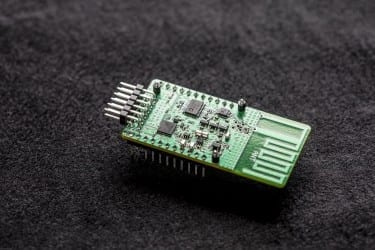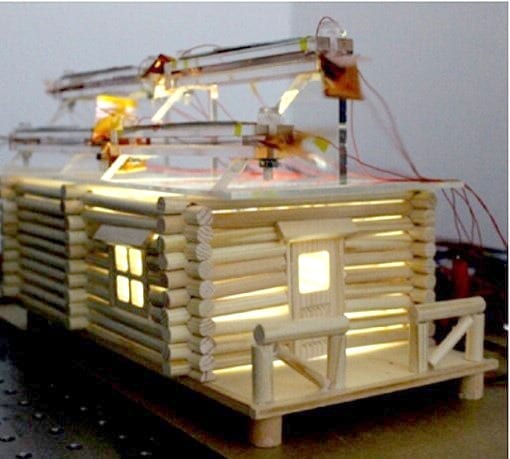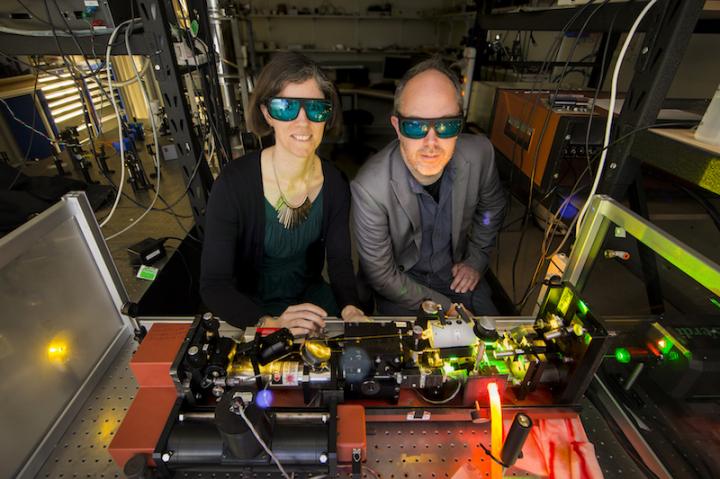
University of Washington researchers have demonstrated for the first time that devices that run on almost zero power can transmit data across distances of up to 2.8 kilometers — breaking a long-held barrier and potentially enabling a vast array of interconnected devices.
For example, flexible electronics — from knee patches that capture range of motion in arthritic patients to patches that use sweat to detect fatigue in athletes or soldiers — hold great promise for collecting medically relevant data.
But today’s flexible electronics and other sensors that can’t employ bulky batteries and need to operate with very low power typically can’t communicate with other devices more than a few feet or meters away. This limits their practical use in applications ranging from medical monitoring and home sensing to smart cities and precision agriculture.
By contrast, the UW’s long-range backscatter system, which uses reflected radio signals to transmit data at extremely low power and low cost, achieved reliable coverage throughout 4800-square-foot house, an office area covering 41 rooms and a one-acre vegetable farm. The system is detailed in a paper to be presented Sept. 13 at UbiComp 2017.
The research team built this flexible epidermal patch prototype — which could be used to collect and wirelessly transmit useful medical data — that successfully transmitted information across a 3,300 square-foot atrium.Dennis Wise/University of Washington
“Until now, devices that can communicate over long distances have consumed a lot of power. The tradeoff in a low-power device that consumes microwatts of power is that its communication range is short,” said Shyam Gollakota, lead faculty and associate professor in the Paul G. Allen School of Computer Science & Engineering. “Now we’ve shown that we can offer both, which will be pretty game-changing for a lot of different industries and applications.”
The team’s latest long-range backscatter system provides reliable long-range communication with sensors that consume 1000 times less power than existing technologies capable of transmitting data over similar distances. It’s an important and necessary breakthrough toward embedding connectivity into billions of everyday objects.
The long-range backscatter system will be commercialized by Jeeva Wireless, a spin-out company founded by the UW team of computer scientists and electrical engineers, which expects to begin selling it within six months.
The communication range of many low-power devices is limited to several feet. The UW’s long-range backscatter system’s sensor (shown in the foreground) was able to communicate with a receiver (held in the distant background) throughout a one-acre farm, a 4,800-square-foot house and an office area covering 41 rooms.Dennis Wise/University of Washington
The sensors are so cheap — with an expected bulk cost of 10 to 20 cents each — that farmers looking to measure soil temperature or moisture could affordably blanket an entire field to determine how to efficiently plant seeds or water. Other potential applications range from sensor arrays that could monitor pollution, noise or traffic in “smart” cities or medical devices that could wirelessly transmit information about a heart patient’s condition around the clock.
“People have been talking about embedding connectivity into everyday objects such as laundry detergent, paper towels and coffee cups for years, but the problem is the cost and power consumption to achieve this,” said Vamsi Talla, CTO of Jeeva Wireless, who was an Allen School postdoctoral researcher and received a doctorate in electrical engineering from the UW. “This is the first wireless system that can inject connectivity into any device with very minimal cost.”
The research team, for instance, built a contact lens prototype and a flexible epidermal patch that attaches to human skin, which successfully used long-range backscatter to transmit information across a 3300-square-foot atrium. That’s orders of magnitude larger than the 3-foot range achieved by prior smart contact lens designs.
The long-range backscatter system uses a source that emits a radio signal, low-power sensors that encode information in reflected signals and an off-the-shelf receiver.Dennis Wise/University of Washington
The system has three components: a source that emits a radio signal, sensors that encode information in reflections of that signal and an inexpensive off-the-shelf receiver that decodes the information. When the sensor is placed between the source and receiver, the system can transmit data at distances up to 475 meters. When the sensor is placed next to the signal source, the receiver can decode information from as far as 2.8 kilometers away.
The advantage to using reflected, or “backscattered,” radio signals to convey information is a sensor can run on extremely low power that can be provided by thin cheap flexible printed batteries or can be harvested from ambient sources — eliminating the need for bulky batteries. The disadvantage is that it’s difficult for a receiver to distinguish these extremely weak reflections from the original signal and other noise.
The UW team also transmitted information across a 3,300 square foot atrium using this “smart” contact lens prototype.Dennis Wise/University of Washington
“It’s like trying to listen to a conversation happening on the other side of a thick wall — you might hear some faint voices but you can’t quite make out the words,” said Mehrdad Hessar, an Allen School doctoral student. “With our new technology we can essentially decode those words even when the conversation itself is hard to hear.”
To overcome the problem, the UW team introduced a new type of modulation — called chirp spread spectrum — into its backscatter design. Spreading the reflected signals across multiple frequencies allowed the team to achieve much greater sensitivities and decode backscattered signals across greater distances even when it’s below the noise.
The long-range backscatter research team includes former UW electrical engineering doctoral students Bryce Kellogg (left), Vamsi Talla (center) and Allen School doctoral student Mehrdad Hessar (right).Dennis Wise/University of Washington
“We basically started with a clean slate and said if what we really need to enable smart applications is long-range communication, how could we design the system from the ground up to achieve that goal?” said Bryce Kellogg, a co-founder at Jeeva Wireless who was a UW electrical engineering student.
Learn more: UW team shatters long-range communication barrier for devices that consume almost no power
The Latest on: Long-range backscatter system
[google_news title=”” keyword=”Mengla virus” num_posts=”10″ blurb_length=”0″ show_thumb=”left”]
via Google News
The Latest on: Long-range backscatter system
- Viruses Newson May 8, 2024 at 5:00 pm
May 2, 2024 — Researchers have found that a brain disorder associated with flu (influenza-associated encephalopathy, or IAE) can be caused by the influenza virus entering the brain from the ...
- Best Antivirus Software for 2024on May 4, 2024 at 11:00 pm
Clifford is a managing editor at CNET, where he leads How-To coverage. He spent a handful of years at Peachpit Press, editing books on everything from the first iPhone to Python. He also worked at ...
- What to know about the bird flu outbreak in the US after virus fragments found in milk sampleson April 24, 2024 at 6:29 pm
Several dairy cows have been infected, resulting in milk samples showing inactive remnants of the virus, and one human case has been confirmed. Health officials say the food supply is safe and the ...
- Next pandemic likely to be caused by flu virus, scientists warnon April 20, 2024 at 1:40 pm
An international survey, to be published next weekend, will reveal that 57% of senior disease experts now think that a strain of flu virus will be the cause of the next global outbreak of deadly ...
- Man who caught virus from a monkey in a critical condition – B virus explainedon April 16, 2024 at 4:33 am
Colin Michie does not work for, consult, own shares in or receive funding from any company or organization that would benefit from this article, and has disclosed no relevant affiliations beyond ...
- West Nile Virus Infectionon April 12, 2024 at 5:00 pm
There is no established treatment for WNV infection. Currently, prevention and control are the only measures that help decrease the morbidity and mortality associated with WNV infection. As the ...
- Bird flu detected among chickens in Texas and Michiganon April 12, 2024 at 4:16 am
Ca-Maine Foods, largest fresh egg producer in US, temporarily halts production at one Texas facility after discovering virus Avian influenza has been detected among chickens in Texas and Michigan ...
- A Random Influx of DNA from a Virus Helped Vertebrates Become So Stunningly Successfulon April 11, 2024 at 5:00 pm
Retroviruses such as the HIV virus carry out this genetic hacking by reversing the sequence of the gene readout. They inject their RNA into the cells they infect, which serves as the code to make ...
- Measles outbreak in Chicago: What to know about the viruson March 27, 2024 at 9:50 am
Though most vaccinated people have close to zero chance of contracting the virus, here’s what to know about the disease. Yes, they do. In fact, measles, which was considered eliminated in the ...
- Inside the Coronaviruson February 3, 2024 at 9:56 am
We show how the immune system would normally attempt to neutralize virus particles and how CoV-2 can block that effort. We explain some of the virus's surprising abilities, such as its capacity to ...
via Bing News










